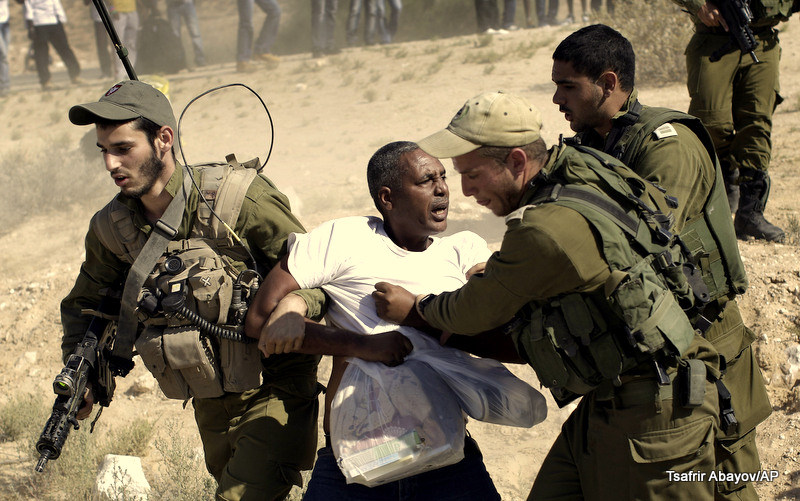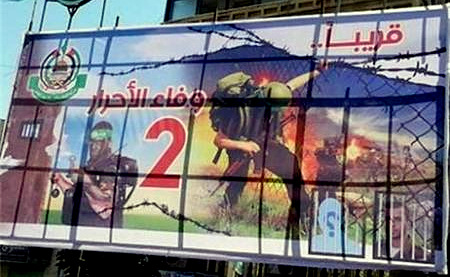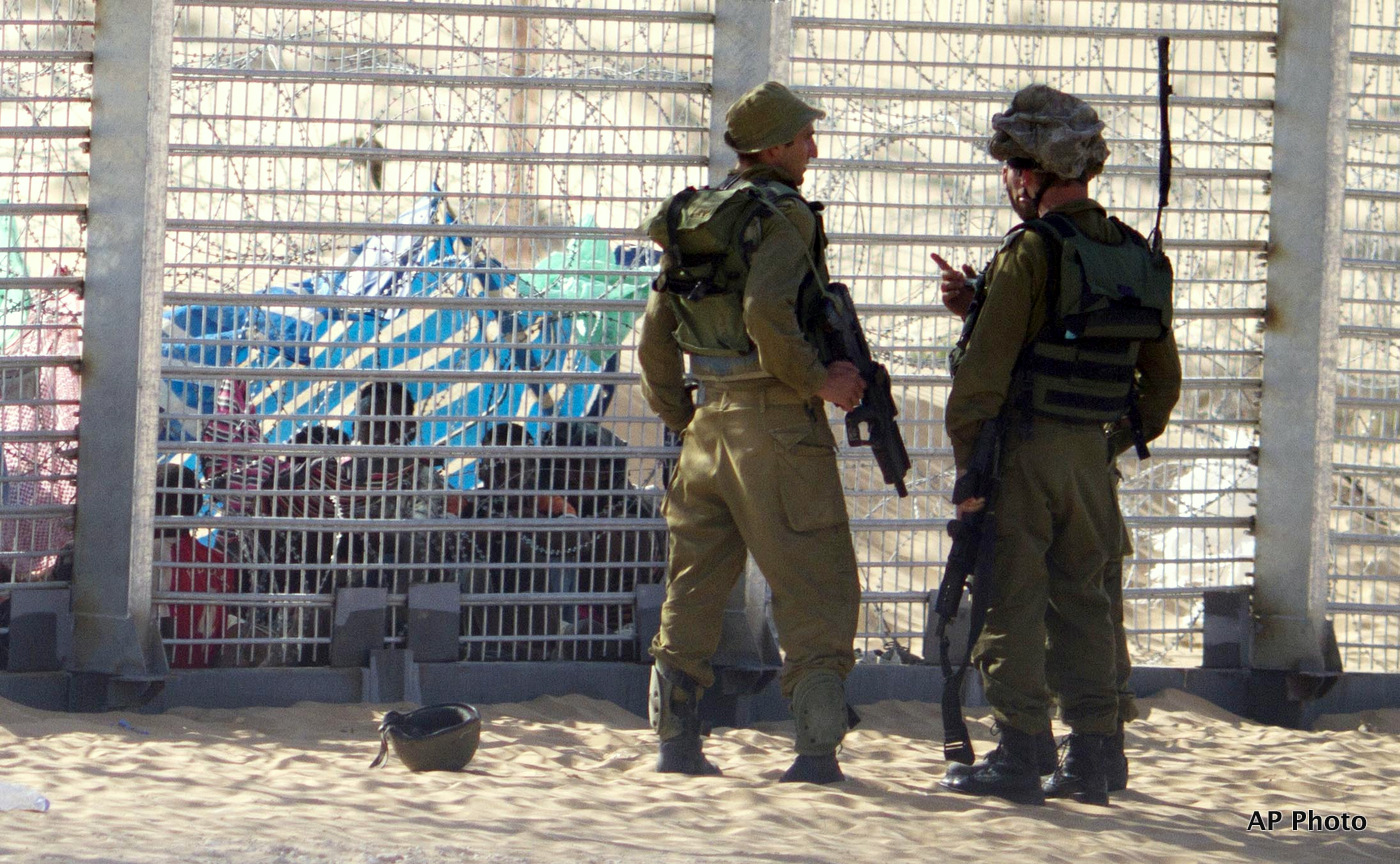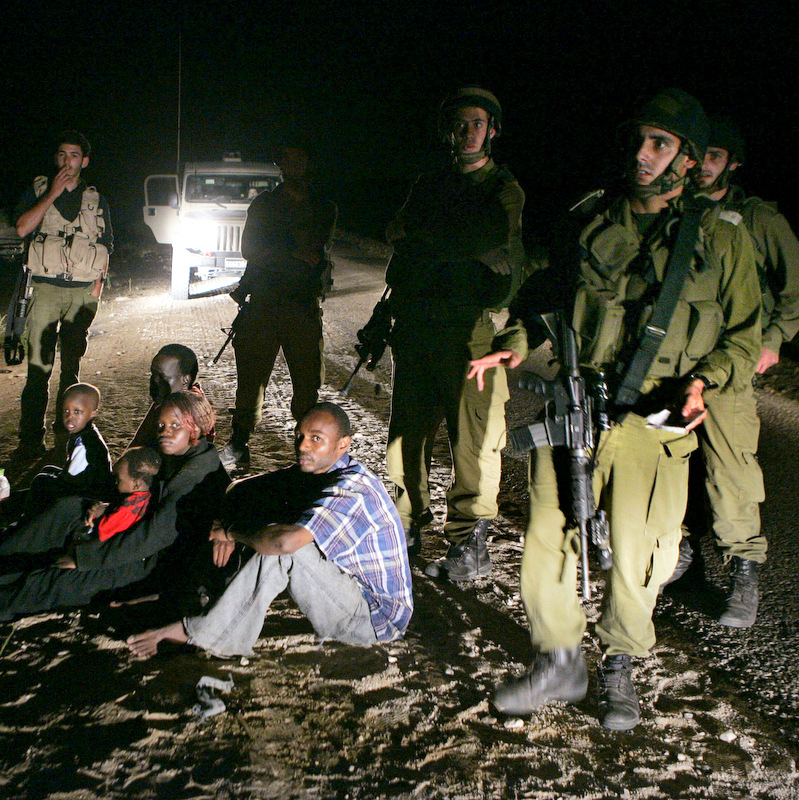 In this Friday, June 27, 2014 file photo, African migrants clash with Israeli soldiers after they left Holot detention center in southern Israel and walked towards the Border with Egypt near the southern Israeli Kibbutz of Nitzana.
In this Friday, June 27, 2014 file photo, African migrants clash with Israeli soldiers after they left Holot detention center in southern Israel and walked towards the Border with Egypt near the southern Israeli Kibbutz of Nitzana.
In October 2014, just after Operation Protective Edge ended, an Israeli Facebook friend of mine reported a rumor that an Ethiopian-Israeli citizen crossed into Gaza and was detained there. The next day I confirmed the truth of the story through an independent Israeli source. Here is what I wrote then:
“An Israeli-Ethiopian from Ashkelon crossed the border into Gaza several weeks ago. The man was allegedly mentally ill and no one knows what drove him to do this. He is being held by authorities in Gaza. Israel has placed a gag order on the incident and the media may not report it. His family has been told not to speak to the media as this might endanger him by raising his profile, though I’d venture to guess that the real reason is that it would embarrass the Israeli government and raise his value in a prisoner exchange.”
Another rumor was that he’d been swimming off the southern coast and a strong current had taken him from Israeli waters to Gaza. Once there, he was reportedly picked up by a vehicle, presumably security officials, and driven away. He hasn’t been seen since.
Hamas offered further circumstantial evidence via a billboard it erected in Gaza which featured images of Oron Shaul, an Israeli Defense Forces soldier, who Israel claims was killed during the war. Shaul’s image is displayed behind bars, indicating that Hamas claims he is alive. Another interesting feature on the billboard is an avatar with a question mark, which indicates Hamas claims it has a mystery captive, which points to the Ethiopian-Israeli.

The Hamas billboard alluding to the detention of Avera Mengistu (the picture next to Shaul Oron’s with a question mark)
Back in October, I tried diligently to follow up on this story without success. But an Israeli published an anonymous comment on my blog last week, naming the captive Ethiopian-Israeli as “Avera Mangisto.” I broadcast this name — probably more likely spelled “Mengistu” in English — via social media, asking if members of the Ethiopian community could confirm it. “O.” did so on Facebook. I asked her if she could help me contact the man’s family. We both did, and she succeeded in interviewing Avera’s divorced father, Aylin, and his brother, Netan’el.
Aylin was more willing to talk. He was saddened and frustrated by the experience. He’d almost lost all hope. Netan’el, after some halting discussions, refused to speak. He directed us not to contact his father either. But before we reached this impasse, O. held several conversations with both of them. They each confirmed that Avera, who is age 24, is being held by the authorities in Gaza.

Facebook photo of detainee Avera Mengistu.
The government instructed the family to remain silent on the matter. Officials told them they were doing everything possible to return him, yet they appear to have done little or nothing. O. said the government “brainwashed” them into believing it was doing something. She added that if Avera were “white” — her term — Israel would have treated him as it did Gilad Shalit, the Ashkenazi Jew for whom Israel exchanged 1,000 Palestinian prisoners.
There is also a gag order on the story, which prohibits Israeli media from covering it. Even some Ethiopian journalists refused to speak with me, concerned about their own vulnerability in Israeli society.
Yesterday, for example, Haaretz quoted Israeli and Hamas officials denying that German foreign minister Franz Steinmeier was once again negotiating for a prisoner exchange which would return the remains of IDF soldiers Oron Shaul and Hadar Goldin to Israel. Not a word in this story about an actual live Israeli held in Gaza. The pernicious gag prohibits it.
This secrecy serves the interests of the Israeli government, but not the interests of the victim. If the public knew about this, they might demand the state do all in its power to free him — which would certainly include the exchange of Palestinian prisoners. The Israeli far-right detests freeing Palestinians it considers terrorists with “blood on their hands.” Whenever the government has freed such prisoners, the extremists have pummeled the ruling Likud party. Netanyahu wishes to avoid this at all costs. And it is far easier to avoid such a situation when the prisoner is Ethiopian, since neither the government nor the public cares as much as it would for a Jewish Israeli prisoner.
The issue of prisoner exchange is indeed so fraught that Israel has instituted the Hannibal Directive, which calls for the army to kill its own soldiers when they are captured alive by Hamas in battle. The IDF would rather murder its own soldiers than have to give up 1,000 Palestinian prisoners to secure the return of a single live Israeli. This controversial policy was invoked several times during Operation Protective Edge.
I twice emailed Israel’s official negotiator assigned to secure the release of prisoners (dead or alive), Col. Lior Lotan, for a response to questions I posed to him about the negotiations. As of press time, I had not heard back from him. I tweeted to Paul Hirschson, a foreign ministry official, asking for help in identifying the Israeli official responsible for these talks. Instead of answering my question, he replied that Hadar Goldin had been buried, implying falsely that Israel was only negotiating about the return of what he called “some body parts.” A second MFA official, Eyal Lampert, whose profile claims he works at the foreign affairs ministry’s “Japan and Korea desk,” said the ministry didn’t pay him enough to deal with “twits [sic] like mine.” He added that neither he nor Hirschson works for “costumer [sic] services.” With such quality staff, it’s easy to understand why Israel’s reputation is what it is in the world.
Operation Solomon as hasbara
 African refugees sit on the ground behind a border fence after they attempted to cross from Egypt into Israel as Israeli soldiers stand guard near the border with Egypt, in southern Israel.
African refugees sit on the ground behind a border fence after they attempted to cross from Egypt into Israel as Israeli soldiers stand guard near the border with Egypt, in southern Israel.
Israel “rescued” thousands of Ethiopians in 1991 and brought them to Zion in Operation Solomon. While the nation basked in the good publicity generated by such a rescue, the reality on the ground was much different. Israel’s chief rabbi did recognize the Ethiopians (known at that time as Falashas) as Jewish, but they were treated little better than Palestinian-Israeli citizens. As polls of Jewish Israelis confirm, racist attitudes toward Palestinians, Mizrahim and Ethiopians are the norm.
Recently, an IDF soldier was walking the streets of Tel Aviv with his bicycle when he was accosted by a private security guard and a police officer. They ripped his bicycle from his hands and assaulted him in broad daylight despite the fact that he was wearing an IDF uniform. Video of the attack was major news on national TV. The country was embarrassed. It would not be unusual for an Ethiopian to be assaulted by the police, but an Ethiopian in an IDF uniform? That trespassed social norms. The police officer was fired from the force and faces a criminal charge — an unusual example of anti-African racism being firmly rejected.
A decade ago, Gabriel Dawit, an Ethiopian-Israeli, drowned, either accidentally or as a suicide in the aftermath of the suicide of his brother, off Nahariya on the northern coast. His body later washed up on the Lebanese coast and was retrieved by Hezbollah. Though the IDF Directorate of Military Intelligence and other security agencies knew this, for three years they didn’t tell the family. The family sued the state, demanding a $500,000 settlement for the suffering inflicted on them. Israel eventually agreed to pay $50,000.
Israel advocates will point out that Yityish “Titi” Aynaw, Miss Israel 2013, is an Ethiopian woman, who is proud of her country and participated in hasbara activities, even re-joining the IDF so she could participate in Operation Protective Edge on the international stage. But tokenism is not the same as true equality, which Ethiopians do not enjoy.
Israel violates international refugee protocols regarding African refugees
 A Sudanese refugee family sit on the ground surrounded by Israeli army soldiers after they crossed illegally from Egypt into Israel. The Israeli Cabinet voted unanimously Sunday, Dec. 11, 2011, to finance a $160 million program designed to staunch the flow of illegal African migrants into Israel by stepping up construction of a border fence and expanding a detention center to hold thousands of the new arrivals. (AP Photo/Ariel Schalit)
A Sudanese refugee family sit on the ground surrounded by Israeli army soldiers after they crossed illegally from Egypt into Israel. The Israeli Cabinet voted unanimously Sunday, Dec. 11, 2011, to finance a $160 million program designed to staunch the flow of illegal African migrants into Israel by stepping up construction of a border fence and expanding a detention center to hold thousands of the new arrivals. (AP Photo/Ariel Schalit)
Israel also has 60,000 African refugees, who fled civil wars, famine and genocide in countries like Eritrea, Sudan and Ethiopia. Unlike the Ethiopians I mentioned above, the former do not have citizenship. In fact, Israel has refused to even offer them rights reserved for refugees under international law. Until recently, there was no provision for hearing asylum requests, and only 45 (.07 percent) such requests have been granted out of thousands of applications to date.
Recently, in violation of international protocols, Israel told many of these individuals that they must agree to “voluntary” deportation (there is a $3,500 “inducement” to agree to leave) or face imprisonment in Saharonim, a prison for violators of immigration laws. Haaretz has been reporting extensively on the plight of those who agree to deportation. These deportees are flown on a plane to Rwanda, whose dictator, Paul Kagame, agreed to accept them in return for economic assistance and arms deals that likely facilitate the genocide in neighboring Congo.
Four such Eritrean refugees from Israel, who were sent to Rwanda, ended up in Libya and were beheaded in the now-infamous Islamic State of Iraq and Syria (ISIS) beach executions. Their relatives remaining in Israel confirmed both their departure and their execution, after watching the horrific video.
Galia Sabar, a Tel Aviv University professor, traveled to the African countries that receive these refugees and researched their living conditions and fate. Her findings, published in Haaretz, reveal that Rwanda has appointed someone who is essentially a smuggler who receives the names of deportees arriving at the Kigali airport from Israeli police. He meets them at the airport, drives them to a guesthouse, tells them they may not leave it, and eventually spirits them out of the country — all the while, taking a cut of all proceeds of their expenses and hiring new smugglers who take them across the Rwandan border into neighboring Sudan.
The refugees have no legal status in Uganda. They live there in squalor, paying hundreds of dollars per month for a rented room or more for a room in a private residence. Such expenses quickly eat up that bribe that Israel provided to persuade them to leave. For obvious reasons, many of these people see Europe as their next hope for refuge, which was how the Eritreans ended up in Libya.
Israel has totally abandoned its responsibilities for these individuals under international humanitarian law. Not that international law is a principle Israel respects in any event.
Richard Silverstein has published the Tikun Olam since 2003. It exposes the secrets and misdeeds of the Israeli national security state. He lives in Seattle.

